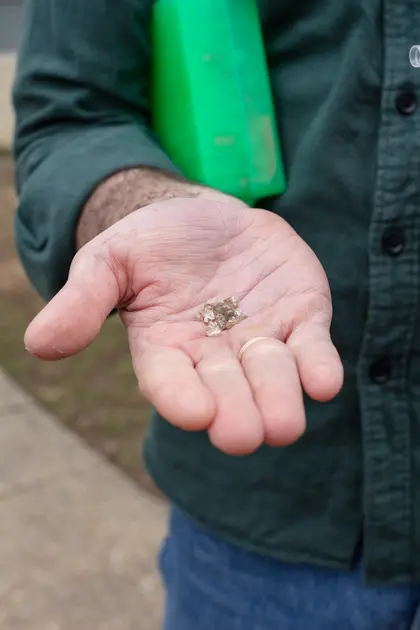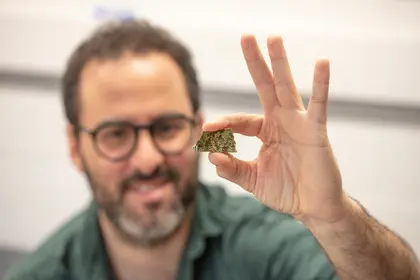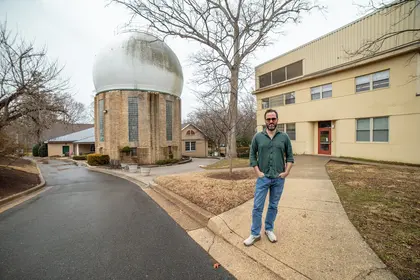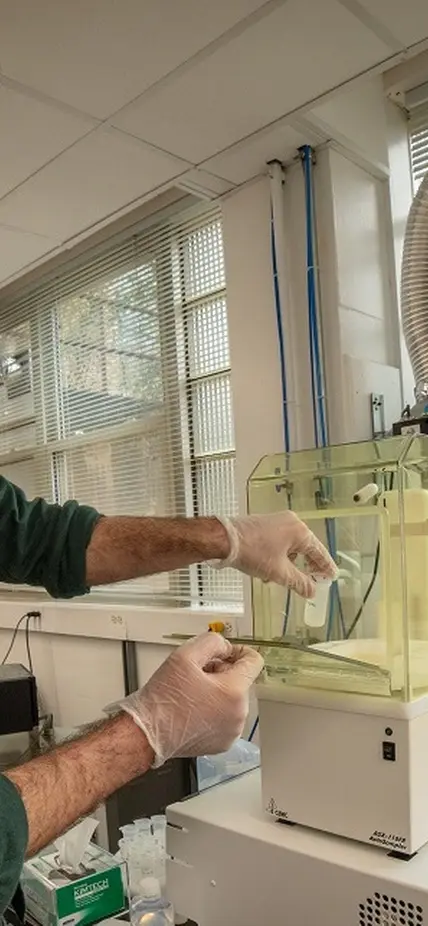
Q: What is your general area of study?
I am a geologist with a combined emphasis in experimental petrology and geochemistry. I study the geochemistry of the Earth’s mantle, and more specifically a special part of the mantle called the lithospheric mantle. My expertise in experimental petrology involves conducting laboratory experiments that are designed to reproduce the conditions under which minerals and rocks are formed. Since we have no means of directly observing or measuring these processes in the Earth’s mantle, these experiments allow us to construct models that indirectly give us information about the composition and structure of deep Earth. My geochemical interests center around the role of mantle-derived melts in the chemical modification of Earth. At Carnegie, I am currently utilizing what we call non-traditional stable isotopes as new proxies in deciphering the geological history of Earth.
Q: What is the coolest thing you’ve worked on so far in your career?
Experimental petrology is really cool because we can literally make our own rocks in the lab—from scratch—by mixing powders and putting them under high pressure and high temperature. We then study how these artificial rocks respond to specific circumstances in a controlled environment, and this allows us to make inferences about the behavior of natural rocks and their formation.
With experimental petrology, you design an experiment with an answer in mind and try to prove your theory. As a geologist, it’s the opposite. I become a detective seeking the answers. I look to rocks to give me certain clues that allow me to make a coherent story about the geological history of a certain area.
I am especially interested in diamonds, and more specifically inclusion-bearing diamonds which diamond dealers often regard as less `precious', because they dont strictly follow the four C’s (Color, Cut, Carat, and Clarity). When most people think about diamonds they think about clear, brilliant cut stones, but for geologists, diamonds with inclusions (little pieces of other rocks, minerals and fluids) are more valuable than the most flawless cut stone. As the inclusions trapped inside the diamond are protected in a very hard sphere, that is chemically inert, they offer a “pristine” look into the dynamics of Earth’s mantle.
About a decade ago, there was a major discovery of a field of diamonds on Baffin Island, in the Northeast territories of Canada that discovered one of the most productive mines for high-value yellow diamonds. I was lucky enough to be able to personally analyze a handful of those samples. By analyzing the diamonds’ and their impurities, (mainly nitrogen), I was able to estimate their residence time in the mantle prior to their delivery to the surface. When I compared that information with the geochemistry of tiny (micron scaled) fluid inclusions that are trapped within the diamonds, I was able to assess the geological history of that locality, strictly from the vantage point of diamond formation. As a geochemist you rarely come around a sample suite that provides you with such a broad overview of a locality's long and complex geological history, which was very exciting to me.

Q: Did you always think you would be a scientist?
My father is a biochemist and professor of biochemistry, so I grew up around science. I am actually a triplet—I have two identical brothers—and when the three of us went to university, both of them followed in my father’s footsteps and studied biology. I, on the other hand, originally pursued social science and education. That lasted for one year, but it wasn’t for me so I ended up changing to geology and geochemistry. That one year was worth it though, because it’s when I met my wife.
Q: Was your love of science shaped by a particular experience or mentor?
I had a number of different mentors and they all had profound and different influences on me and my career, but I don’t want to name just one in particular. One experience that sparked my interest in geology and geochemistry was a big trip I took after the army to South America. I found myself really connected to the landscapes there and became curious about the earth and the different topographies, and that led me down the path of geology.
Q: Do you have a favorite isotope and why?
I have two. The first one is potassium. It’s actually a minor element in Earth's mantle—there is not a lot of it. The fluids found in diamonds, however, are very potassium-rich. Up until recently, we weren’t able to measure the stable isotopes of potassium in the laboratory, but recent analytical advancements have made measurement possible. So now I am able to measure potassium in diamonds, which has never been done before. It’s a challenge because when you analyze diamonds, they are (relatively speaking) small and the inclusions are even smaller, so you don’t have a lot of material to work with. To overcome this issue, I have been collaborating with some geologists in Israel and by using a powerful laser in a clean environment like water, we can retrieve enough material to do any kind of analysis we want to do.
My other favorite isotope is silicon, which is the major element (after oxygen) that makes up rocks. I am interested in the way that Silicon isotopes behave in one of Earth’s predominant minerals called olivine. If you take a piece of earth’s mantle around more than 50% percent will be olivine. Something unique about olivine is that when you start to go deeper into the mantle, its mineral structure changes as a function of pressure and temperature. There have been theoretical studies about how isotopes, like silicon, behave as a function of these transitions, but no one has yet been able to make a definitive determination. I am using experiments to understand how isotopes are distributed between the different phases of olivine’s structural changes.
Q: What are some of the challenges you have encountered in your career so far and how did you address them?
Writing papers, especially for a non-native English speaker, can be a challenge. It’s more complicated than just writing about results or equations. In order for your paper to capture attention and spark discussions you really have to tell a story and storytelling is a very specific skill set.
Another challenge is that, quite simply, experimentation can be hard and very frustrating at times. For my master’s degree I did one experiment ten times. I do love to bicycle, and find that it’s a great outlet to relieve stress.
Also, I have three kids, so time is a big challenge. As a parent you always feel like you aren’t doing enough, and you’re constantly trying to juggle work and home life and find that balance.

Q: What advice would you give to graduate students and others who are just starting their scientific careers?
Don’t become a geologist (just joking). In all seriousness, know who you are and what your strengths are, but don’t be afraid to expand your limits and build new strengths. Also, when you are just starting out don’t assume that everyone else knows more than you. You know what you are doing. You will face criticism and you have to be open to new ideas, but be confident in yourself.
Q: What do you think is the most exciting research direction happening in your field right now?
Combining old and new old techniques and the use of big data, especially in the study of isotopes, is the way that my field is moving forward. It’s a matter of looking at new patterns through the lens of big data and trying to measure isotopic systems in a way that was previously unavailable to us.
Q: Looking 10 years ahead, what future development do you think will have the greatest impact on your field?
The big buzzword today is artificial intelligence. To be honest, though, I have yet to see a breakthrough using A.I. What I find exciting is that we’re getting to a point where we can do multiple studies on a given sample and the precision and accuracy of results is significantly improving for smaller and smaller sample sizes. It used to be that you needed a huge rock to date it. But now you can date very small occlusions in diamonds, something unheard of just a few years ago.
Ultimately, combining different disciplines is becoming more and more of a benchmark in telling your story. There’s no way around it—big data is becoming increasingly important to the process of analytical measurement.

Q: Why did you decide to do a postdoctoral position at Carnegie?
It’s the best place to do research in geochemistry. It has an incredible legacy and amazing scientists. As a graduate student, you read the papers of Carnegie scientists and they are so impressive. And now I’m actually working here—Carnegie really is a dream come true.
Q: What has your experience at Carnegie meant to you?
Carnegie is the best place in the world to become an independent scientist. It’s an organization that provides all the resources you need to become successful. And the staff scientists are the most elite in the world, so you are working among the best of the best. Also, you have the freedom to pursue whatever avenue of study you want to. You can even change course as you go. In other organizations, postdocs are assigned specific projects and that’s all they work on. For so many reasons, Carnegie is just an ideal place to mature as a scientist.
